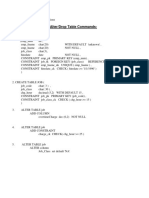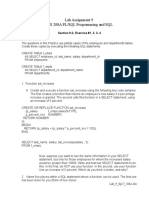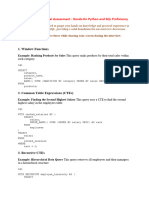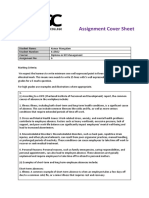100%(1)100% found this document useful (1 vote)
686 viewsInf3707 202 2014 4 B
Inf3707 202 2014 4 B
Uploaded by
d_systemsugandaDatabase design and Implementation
Copyright:
© All Rights Reserved
Available Formats
Download as PDF, TXT or read online from Scribd
Inf3707 202 2014 4 B
Inf3707 202 2014 4 B
Uploaded by
d_systemsuganda100%(1)100% found this document useful (1 vote)
686 views7 pagesDatabase design and Implementation
Original Title
inf3707_202_2014_4_b
Copyright
© © All Rights Reserved
Available Formats
PDF, TXT or read online from Scribd
Share this document
Did you find this document useful?
Is this content inappropriate?
Database design and Implementation
Copyright:
© All Rights Reserved
Available Formats
Download as PDF, TXT or read online from Scribd
Download as pdf or txt
100%(1)100% found this document useful (1 vote)
686 views7 pagesInf3707 202 2014 4 B
Inf3707 202 2014 4 B
Uploaded by
d_systemsugandaDatabase design and Implementation
Copyright:
© All Rights Reserved
Available Formats
Download as PDF, TXT or read online from Scribd
Download as pdf or txt
You are on page 1of 7
INF3707/202/2/2014
Tutorial Letter 202/2/2014
Database Design and Implementation
Semester 1
School of Computing
This tutorial letter contains important
information about your module.
Bar code
INF3707
2
3. Assignment 2 Solutions
Question 1 (Lesson 4)
a. The Human Resources department needs a report that displays the job ID and the average monthly
salary for each job that has an average payroll that is between 5000 and 10000. The report should not
include clerks. Sort the list in descending order of average salary. Sample results are shown below.
[6]
Solution
sel ect j ob_i d, avg( sal ar y) " Aver age sal ar y"
f r omempl oyees
wher e j ob_i d not l i ke ' %CLER%'
gr oup by j ob_i d
havi ng avg( sal ar y) bet ween 5000 and 10000
or der by avg( sal ar y) desc
b. Create a query that displays the minimum, maximum, and total salary for each job type and the date
the query was run. Sample results are shown below. [4]
Solution
sel ect j ob_i d,
mi n( sal ar y) Mi ni mum,
max( sal ar y) Maxi mum,
sum( sal ar y) Sum,
sysdat e Dat e
f r omempl oyees
gr oup by j ob_i d
Question 2 (Lesson 6)
The human Resources department needs to find the names and hire dates for all employees who were hired
before 29 J anuary 2000, along with their managers names. Sample results are shown in the table below.
[6]
Solution
sel ect w. l ast _name " Wor ker Name" ,
w. hi r e_dat e " Hi r e Dat e" ,
m. l ast _name " Manager Name"
f r omempl oyees w j oi n empl oyees m
on w. manager _i d = m. empl oyee_i d
wher e w. hi r e_dat e <= ' 29- J AN- 2000'
INF3707/201
3
Question 3 (Lesson 6)
The Human Resources department requires you to find details of employees who earn salary that is more
than the average salary for each department. Sample results are shown in the table below.
[6]
Solution
sel ect l ast _name, sal ar y, depar t ment _i d
f r omempl oyees
wher e sal ar y >= any ( sel ect r ound( avg( sal ar y) , 2)
f r omempl oyees
gr oup by depar t ment _i d)
//alternative answer
sel ect a. l ast _name, a. depar t ment _i d f r omempl oyees a
wher e sal ar y > ( sel ect avg( b. sal ar y) f r omempl oyees b
wher e b. depar t ment _i d = a. depar t ment _i d
gr oup by b. depar t ment _i d)
or der by a. sal ar y desc
Question 4 (Lesson 7)
a. The job history table keeps record of the employees that filled other positions (job_ids) within the
organization. Use one of the set operators to list the employee information (name and last name) for
all those employees that have never filled any other position within the organization .The report must
list the employee_id and employee last name and first name. Order the list by the employee_id.
[4]
b. Use one of the set operators to list the names of all the employees that are in the Shipping
Department and reports to Steven King. Sort the report alphabetically according to the last name of
the employee. [4]
Solution
a.
sel ect empl oyee_i d, l ast _name, f i r st _name f r omempl oyees
MI NUS
sel ect empl oyee_i d, TO_CHAR( NULL) , TO_CHAR( NULL) f r om
j ob_hi st or y
or der by empl oyee_i d;
// alternative
sel ect empl oyee_i d, l ast _name, f i r st _name f r omempl oyees
wher e empl oyee_i d i n ( sel ect empl oyee_i d f r omempl oyees
MI NUS
sel ect di st i nct empl oyee_i d f r omj ob_hi st or y)
or der by 1 asc
b.
sel ect l ast _name, f i r st _name f r omempl oyees wher e manager _i d =
100
i nt er sect
4
sel ect l ast _name, f i r st _name f r omempl oyees wher e depar t ment _i d =
90
or der by l ast _name;
Question 5 (lesson 8)
a. Run the statement in the lab_08_01.sql scripts to build the MY_EMPLOYEE table to be used for the
lab. [2]
b. Describe the structure of the table to identify the column names. [2]
c. Write an insert statement in a dynamic reusable script file to load rows into the MY_EMPLOYEE
table. [2]
Solution
a. run the script
b. describe My_EMPLOEE
c.
i nser t i nt o my_empl oyee
val ues( : i d, : f i r st _name, : l ast _name, : user i d, : sal r y)
Question 6(Lesson 9)
Create the EMPLOYEES_2 table based on the structure of the EMPLOYEES table. Include only the
employees_id, initial of first name, last name, the last four digits of the phone number, salary dived by 2,
and department id. Name the columns in the new table as ID, INITIAL, SURNAME, PHONE
EXTENSION, SALARY, DEPRTMENT. [8]
Solution
cr eat e t abl e empl oyees_2 as
sel ect empl oyee_i d I D,
subst r ( f i r st _name, 1, 1) I ni t i al ,
l ast _name Sur name,
subst r ( phone_number , 9, 12) " Phone Ext ensi on" ,
( sal ar y/ 2) Sal ar y,
depar t ment _i d Depar t ment
f r omempl oyees
Question 7(Lesson 10)
a. Create the EMPLOYEES_3 table based on the structure of the EMPLOYEES table. Include only the
employees_id, first name and last name. Delete all the data from the new table that you have just
created if there is any. Check if all the data has been deleted from the table. [3]
b. Provide the SQL to create a sequence EMP_SEQ_01. This sequence will be used to insert data into
the EMPLOYEES_3 table. The sequence should start at 2010 and have a maximum value of 2999.
Have your sequence increment by 2. [4]
c. Provide the SQL to dynamically insert values into the EMPLOYEES_3 table. Remember to use the
sequence you have created in the previous question. [2]
Solution
a.
i . cr eat e t abl e empl oyee_3 as
sel ect empl oyee_i d, f i r st _name, l ast _name
f r omempl oyees
INF3707/201
5
i i . del et e f r omempl oyee_3
//alternative answer
t r uncat e t abl e empl oyee_3
i i i . sel ect * f r omempl oyee_3
//alternative answer
Sel ect count ( *) f r omempl oyees_3
b. cr eat e sequence empl oyee_seq_03
i ncr ement by 2
st ar t wi t h 2010
maxval ue 2999
nocache
nocycl e
c. i nser t i nt o empl oyee_03
val ues ( empl oyee_seq_01. next val , : f i r st _name, : l ast _name)
Question 8 (Lesson 11)
Provide the SQL, that will prompt the user for the name of the table. This SQL will then provide a report
that will list the column names, data types, data types lengths, data precision, indicate whether NULLS are
allowed for this specific table. Provide suitable aliases / headings for the columns. Keep in mind that the
table name must be in capital letters use a suitable converter to convert the text that the user enter into
capital letters. [5]
Solution
sel ect col umn_name COLNAME, dat a_t ype TYPE, dat a_l engt h LENGTH,
dat a_pr eci si on PRECI SI ON, NULLABLE
f r omuser _t ab_col umns
wher e t abl e_name = upper ( : TABLENAME) ;
Question 9 (Lesson 1 Fundamentals 11)
J ohn is a new employee who works as an Application Developer who has recently joined your company. As
a DBA create a user name and password for J ohn to have access to your oracle database, initialize his
password to his name. J ohns role is a developer and has privileges to create session, create table, create
sequence and create view. Confirm that the role has been created by querying the data dictionary. [10]
Solution
cr eat e user J ohn
i dent i f i ed by j ohn;
cr eat e r ol e devel oper ;
gr ant cr eat e sessi on, cr eat e t abl e, cr eat e sequence, cr eat e vi ew
t o devel oper ;
6
gr ant devel oper t o J ohn;
sel ect * f r omdba_r ol es
wher e r ol e = upper ( ' devel oper ' ) ;
Question 10 (Lesson 3 Fundamentals 11)
a. Provide the SQL that will create the table EMPDATA based on the structure of the EMPLOYEES
and DEPARTMENTS tables. Include only the EMPLOYEE_ID, FIRST_NAME, LAST_NAME,
SALARY and DEPARTMENT_NAME columns. Name the columns in the new table as ID, NAME
(concatenate the FIRST_NAME and LAST_NAME), SALARY, DEPTNAME. (5)
b. Provide the SQL that will alter the table EMPDATA and add a PRIMARY KEY on the ID column.
(2)
c. Provide the SQL that will display the object names and types from the USER_OBJ ECTS data
dictionary view for the EMPLOYEES and EMPDATA tables. (4)
d. Provide the SQL that will drop EMPDATA in such a way that it cannot be restored. (1)
Solution
a.
cr eat e t abl e EMPDATA as
sel ect e. empl oyee_i d I D, e. f i r st _name | | ' ' | | e. l ast _name NAME,
e. sal ar y SALARY, d. depar t ment _name
f r omempl oyees e, depar t ment s d
wher e e. depar t ment _i d = d. depar t ment _i d;
b.
al t er t abl e EMPDATA
add const r ai nt empdat e_i d PRI MARY KEY ( I D) ;
c.
sel ect obj ect _name, obj ect _t ype
f r omuser _obj ect s
wher e obj ect _name i n ( ' EMPDATA' , ' EMPLOYEES' ) ;
d.
dr op t abl e empdat a pur ge;
Question 11(Lesson 4 Fundamentals 11)
Write a query to display the following for those employees whose manageID is less than 120:
Manager ID
J ob and total salaries for every job for employees who report to the same manager
Total salary for those mangers
Cross-tabulation values to display the total salary for every job, irrespective of the manager
Total salary irrespective of all job titles (10)
Solution
SELECT manager _i d, j ob_i d, sum( sal ar y)
FROM empl oyees
WHERE manager _i d < 120
GROUP BY ROLLUP( manager _i d, j ob_i d) ;
Question 12 (lesson 6 Fundamentals 11)
INF3707/201
7
Provide the SQL, which will dynamically request an employee id. The report will then display the details of
all the employees that are managed by the same manager as the employee_id that was read and work in the
same department. Use a non-pair wise comparison sub query. (10)
Solution
sel ect empl oyee_i d, manager _i d, depar t ment _i d
f r omempl oyees
wher e manager _i d I N
( sel ect manager _i d f r omempl oyees
wher e empl oyee_i d =: empi d1)
AND depar t ment _i d I N
( sel ect depar t ment _i d f r omempl oyees
wher e empl oyee_i d = : empi d1)
AND empl oyee_i d <> : empi d1
2014
You might also like
- Design of Offshore Steel Structures, General (LRFD Method) : Offshore Standard DNV-OS-C101Document49 pagesDesign of Offshore Steel Structures, General (LRFD Method) : Offshore Standard DNV-OS-C101Dennyza100% (1)
- DBMS Lab Manual BCS403Document42 pagesDBMS Lab Manual BCS403Aman Singh100% (1)
- Practice Solutions Oracle SQLDocument32 pagesPractice Solutions Oracle SQLAndrea Castelli67% (6)
- Student Book (Melody Class)Document12 pagesStudent Book (Melody Class)melody chit50% (2)
- ADBTLab Manua115-16Document45 pagesADBTLab Manua115-16EdenNo ratings yet
- Practice 1 To 15 and AnswersDocument47 pagesPractice 1 To 15 and Answersmalik baidarNo ratings yet
- The Subjunctive Mood: Come What May Be That As It May Suffice It To SayDocument1 pageThe Subjunctive Mood: Come What May Be That As It May Suffice It To SayPetra BajacNo ratings yet
- LABFAT20BCE0647Document9 pagesLABFAT20BCE0647Nikitha JohnNo ratings yet
- Ansh IsmlDocument32 pagesAnsh Ismlsatvikvishnoi0805No ratings yet
- Lab Manual SQLDocument20 pagesLab Manual SQLAnkit KushwahaNo ratings yet
- Databse 4-5Document6 pagesDatabse 4-5Mariam ZakaryaNo ratings yet
- ORACLE Fundamental - SQL 1 آاروأ أ: Moh&AliDocument6 pagesORACLE Fundamental - SQL 1 آاروأ أ: Moh&AliuserNo ratings yet
- DBMS Lab Manual BCS403Document43 pagesDBMS Lab Manual BCS403aryananil00007No ratings yet
- DB Assignment of CHP 5,6,7,9Document22 pagesDB Assignment of CHP 5,6,7,9M Asif khanNo ratings yet
- Write SQL Query To Find Employees That Have Same Name and EmailDocument93 pagesWrite SQL Query To Find Employees That Have Same Name and Emailvr.sf99No ratings yet
- Answers To SQL Practice QuestionsDocument20 pagesAnswers To SQL Practice Questionsnuwandara abeykoonNo ratings yet
- Practice 3, Part 1 1.: Introduction To Oracle9i: SQL 3Document15 pagesPractice 3, Part 1 1.: Introduction To Oracle9i: SQL 3John Paul Duque GutierrezNo ratings yet
- BCS403 3Document1 pageBCS403 3Benakappa S MNo ratings yet
- Laboratory Activity No 1Document4 pagesLaboratory Activity No 1Llal SantiagoNo ratings yet
- Database Lab ExerciseDocument4 pagesDatabase Lab ExerciseobsinaafmohammedNo ratings yet
- DBMS_QB_IA2_AnsDocument29 pagesDBMS_QB_IA2_AnsLakshmi pathiNo ratings yet
- D17108GC30 Add Prac SolutionDocument13 pagesD17108GC30 Add Prac SolutionCitra NNo ratings yet
- DBWorksheet UpdateDocument34 pagesDBWorksheet UpdateLara AbuDayehNo ratings yet
- Solutions 3 (SQL)Document2 pagesSolutions 3 (SQL)poo999333111No ratings yet
- DBMS Lab Manual BCS403Document42 pagesDBMS Lab Manual BCS403sahvishaikhNo ratings yet
- DBMS Lab Manual (BCS403)Document18 pagesDBMS Lab Manual (BCS403)Disha KMNo ratings yet
- Lab ICT501Document11 pagesLab ICT501Sitti Rezkinaah NurdinNo ratings yet
- papersolution_insemDocument12 pagespapersolution_insemdarshankhairnar100103No ratings yet
- Oracle Practices 9 12Document17 pagesOracle Practices 9 12ermaquina970% (1)
- m8 Formdoc Bautista IshmaelDocument12 pagesm8 Formdoc Bautista IshmaelIsh BautistaNo ratings yet
- Homework No:2: CAP301: Database Management SystemDocument12 pagesHomework No:2: CAP301: Database Management SystemSurendra Singh ChauhanNo ratings yet
- 2nd IA QBDocument12 pages2nd IA QBSrinivas DNo ratings yet
- SQL Query Interview Questions and Answers: (Salary) Employee Salary NOT ( (Salary) Employee)Document5 pagesSQL Query Interview Questions and Answers: (Salary) Employee Salary NOT ( (Salary) Employee)uma100% (1)
- ADBMSDocument6 pagesADBMSKaushik GhoshNo ratings yet
- Practice 3,4 v5Document6 pagesPractice 3,4 v5Zeiad MansourNo ratings yet
- Lab 9 Sp17 208ADocument7 pagesLab 9 Sp17 208AAlfonso TorresNo ratings yet
- ProblemDocument5 pagesProblemMuhammad QodlyNo ratings yet
- Oracle Practices 9 12Document17 pagesOracle Practices 9 12ermaquina97No ratings yet
- Practice 5 PDFDocument5 pagesPractice 5 PDFuserNo ratings yet
- Rdbms Lab-5: Jenma Maria Binoy Rollno 34Document6 pagesRdbms Lab-5: Jenma Maria Binoy Rollno 34Jenma Maria BinoyNo ratings yet
- Casapao Laboratory Activity No. 3 Part 2Document5 pagesCasapao Laboratory Activity No. 3 Part 2qjmacasapaoNo ratings yet
- AssignmentsDocument11 pagesAssignmentsRaghul RaviNo ratings yet
- Practice 1 PDFDocument4 pagesPractice 1 PDFuserNo ratings yet
- Experiment:-1: Introduction About SQLDocument19 pagesExperiment:-1: Introduction About SQLTarun KhandelwalNo ratings yet
- dbms pdfDocument17 pagesdbms pdfTrialNo ratings yet
- Queyquep MIDTERM PRACTICESET8Document10 pagesQueyquep MIDTERM PRACTICESET8annikaNo ratings yet
- Exercises On HR DatabasesDocument22 pagesExercises On HR DatabasesSadia Islam ShefaNo ratings yet
- Lab Assignment 2Document12 pagesLab Assignment 2maimoonamustafviNo ratings yet
- LabWorks ObjectivesDocument5 pagesLabWorks Objectivesad9861783880No ratings yet
- SQL Fundamentals I Solutions 03Document4 pagesSQL Fundamentals I Solutions 03technitty100% (1)
- Assn2Fall2010 SolutionDocument11 pagesAssn2Fall2010 SolutionAlexander LionheartNo ratings yet
- DEBasic Test Que NAnsDocument15 pagesDEBasic Test Que NAnsomkarsatapathy001No ratings yet
- 2021imsmt021 Rahul Singh ChauhanDocument35 pages2021imsmt021 Rahul Singh ChauhanShabbaz AnsariNo ratings yet
- DBMS Experiment - Lab 2Document18 pagesDBMS Experiment - Lab 222053419No ratings yet
- SQL Query Interview Questions and AnswersDocument14 pagesSQL Query Interview Questions and AnswersRaghu GowdaNo ratings yet
- Lab 9 Sp17 208ADocument8 pagesLab 9 Sp17 208AlucasNo ratings yet
- OracleDocument7 pagesOracleSia LlejeNo ratings yet
- ORACLE Fundamental - SQL 1 آاروأ أ: Moh&AliDocument4 pagesORACLE Fundamental - SQL 1 آاروأ أ: Moh&AliuserNo ratings yet
- SQL 5Document10 pagesSQL 5El ClubNo ratings yet
- DB2 11.1 for LUW: SQL Basic Training for Application DevelopersFrom EverandDB2 11.1 for LUW: SQL Basic Training for Application DevelopersNo ratings yet
- DB2 11 for z/OS: SQL Basic Training for Application DevelopersFrom EverandDB2 11 for z/OS: SQL Basic Training for Application DevelopersRating: 4 out of 5 stars4/5 (1)
- Weekly Home Learning Plan PEDocument8 pagesWeekly Home Learning Plan PEEdmar PenuelaNo ratings yet
- Charles Johnson Benjamin Tucker On Anarcho CapitalismDocument5 pagesCharles Johnson Benjamin Tucker On Anarcho Capitalismdark.kothorNo ratings yet
- Assessment of Fetal Growth and DevelopmentDocument84 pagesAssessment of Fetal Growth and DevelopmentAlessandra Franchesca CortezNo ratings yet
- Phenolic Resins For Curing Elastomers Nov 2003Document31 pagesPhenolic Resins For Curing Elastomers Nov 2003Mahmood Anwar ShadNo ratings yet
- Black MooreDocument2 pagesBlack Mooreserenity42No ratings yet
- Aulia Rizqina Observation Report of Cross Culture UnderstandingDocument7 pagesAulia Rizqina Observation Report of Cross Culture UnderstandingAULIA RIZQINANo ratings yet
- A Photograph - E LearningDocument5 pagesA Photograph - E LearningQudsiyah AdvaniNo ratings yet
- Job Analysis Is The Systematic Process of Collecting and Making Judgments About All The Important Information Related To A JobDocument8 pagesJob Analysis Is The Systematic Process of Collecting and Making Judgments About All The Important Information Related To A JobSamadNo ratings yet
- Operating and Financial Leverage: Foundations of Financial ManagementDocument33 pagesOperating and Financial Leverage: Foundations of Financial Managementalaa_h1No ratings yet
- Atomic Structure Full Notes 50 PageDocument52 pagesAtomic Structure Full Notes 50 PageSubhajit GoraiNo ratings yet
- Ohsc Assignment 6Document6 pagesOhsc Assignment 6Kumar MangalamNo ratings yet
- Monofilament Fishing Line As A Threat To American Oystercatchers (Haematopus Palliatus) On The Texas Coast, USADocument5 pagesMonofilament Fishing Line As A Threat To American Oystercatchers (Haematopus Palliatus) On The Texas Coast, USABurhan ŞahinNo ratings yet
- Back To Back DrawingDocument1 pageBack To Back DrawingProjectYESNo ratings yet
- Unit 8. E10Document5 pagesUnit 8. E10Bob MacauNo ratings yet
- Speedmaths ShortcutsDocument6 pagesSpeedmaths ShortcutsShiv Ram Krishna100% (5)
- The Black Tulip: Alexandre DumasDocument17 pagesThe Black Tulip: Alexandre DumasMussab MasriNo ratings yet
- EschatologyDocument36 pagesEschatologyAndi KazaniNo ratings yet
- Final DemoDocument8 pagesFinal DemoCharlene MaximoNo ratings yet
- Case Study Responsibility AccountingDocument6 pagesCase Study Responsibility Accountingmonika thakur100% (1)
- Icar Syllabus-Physics, Chemistry, Maths, Bio & AgricultureDocument26 pagesIcar Syllabus-Physics, Chemistry, Maths, Bio & AgricultureMota Chashma75% (4)
- Chp9 Sclera DiseasesDocument23 pagesChp9 Sclera DiseasesUchyIntamNo ratings yet
- Mantaur WizardDocument4 pagesMantaur WizardbobsmithNo ratings yet
- Test PronounsDocument2 pagesTest PronounsdenyNo ratings yet
- Cohn (1997) Existential Thought and Therapeutic Practice. An Introduction To Existential Psychotherapy (CAP 2)Document12 pagesCohn (1997) Existential Thought and Therapeutic Practice. An Introduction To Existential Psychotherapy (CAP 2)Marcela Castro BecerraNo ratings yet
- Delta CNC - C - ENDocument44 pagesDelta CNC - C - ENErsin AkyüzNo ratings yet
- Cot Statistics Reylyn 2022 2023 Cot 2Document4 pagesCot Statistics Reylyn 2022 2023 Cot 2Jeffrey AlfonsoNo ratings yet
- Jasperpogi 111Document12 pagesJasperpogi 111Charles Javier GuanzonNo ratings yet

























































































